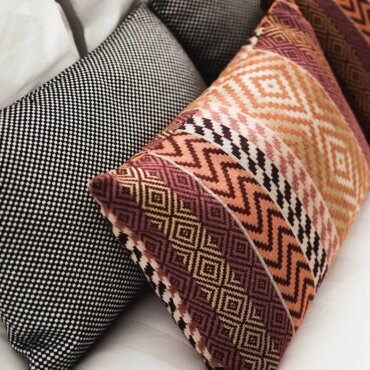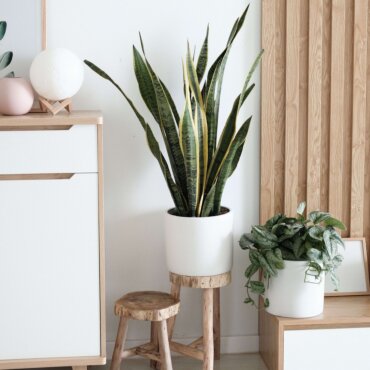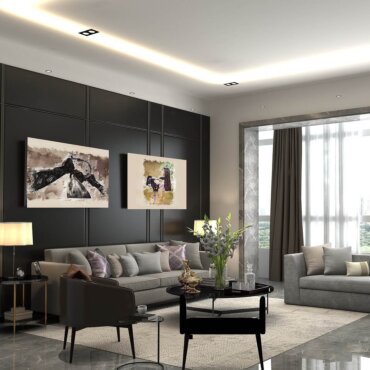
What material is used for decorative pillows?
Decorative pillows play a crucial role in interiors. They are an essential element of every living room and bedroom. They add warmth and coziness to the space. They complement the dominant style of the room and provide a comfortable place to lean back. They are most often placed on sofas, but they can also be found on armchairs and chairs. In the bedroom, they complement the bedding set on the bed. They are often added as a decorative element to a blanket-covered bed, thus enhancing the room's character.
Some of us change our accessories with the current season. It's the easiest and cheapest way to reflect the spirit of the moment. Floral motifs dominate in summer, while holiday-themed motifs and those associated with the season dominate in winter.
What material for decorative pillows?
When choosing decorative pillows, the material from which they are made will be crucial. It will be important for its functional qualities, practical aspects, and the style it will add to the interior. A velvet pillow offers different options, while an eco-friendly canvas one offers others. Everyone has slightly different priorities and expectations for this accessory. For some, a pillow that's pleasant to the touch is paramount. Others prioritize functionality above all. Therefore, the most important criteria when choosing a pillow will be ease of cleaning and wrinkle resistance. What materials can we choose for decorative pillows?
Velvet cushions
This material is very similar to velvet. Its greatest advantage is its softness. Velvet pillows are very pleasant to the touch, making them comfortable to lean on. Their surface drapes differently depending on the texture you apply. This fabric is flexible and easy to care for. The covers are machine washable. Pillows made of velvet look very elegant. The texture of the material, which has a subtle sheen, gives it a very presentable look.
Braided pillows
This popular material features a distinctive weave and is a blend of polyester and viscose. Pillows made from it typically feature colorful patterns. They add interesting accents to the interior and create a unique character. A major advantage of braid is its durability. It's a relatively lightweight material that holds its shape well and is resistant to deformation. Pillowcases with fillings retain their original shape for a long time, which is why they are so popular.
Milton pillows
Milton is a knitted upholstery fabric. It's popular with upholsterers due to its weave and durability. Milton cushions are an excellent choice for those who don't want to change their textile décor too often and prefer high-quality items that will last a long time. This modern fabric, Milton, has hydrophobic properties that make it moisture-repellent and stain-resistant. Despite its thickness, it remains pleasant to the touch. Cushions made from it can adorn sofas and couches made from the same material, or be used in arrangements with completely different upholstery fabrics.
Scene fabric pillows
Scene fabric is a blend of viscose and cotton. It's often used for curtains, throws, and upholstered headboards. It's also used for decorative pillows . This fabric allows for a rich color, making interior accessories made from it a strong, eye-catching accent. It can completely transform the character of a living room or bedroom.
Linen pillowcase
Linen is an ideal choice for lovers of natural materials. This linen pillowcase, in subdued hues reminiscent of natural colors, will perfectly complement an interior dominated by wood and stone. The material has a delicate texture, and the addition of other natural fibers like cotton and viscose makes it wrinkle-resistant and easy to wash.
What filling should you use for decorative pillows?
The material from which the covers of decorative pillows are made is just as important as their filling. It determines whether the pillows will be firmer or softer. The filling also determines their durability. So, what are the most popular fillings for decorative pillows?
Decorative pillows with synthetic filling
Polyester and bamboo fibers are most commonly used in this type of pillow. They are very popular and also the cheapest. These materials are especially recommended for allergy sufferers, as they don't cause allergic reactions. These products are easy to care for and machine washable, even at high temperatures. Synthetic pillow filling absorbs moisture well and provides adequate breathability. The downside, however, is that this filling isn't long-lasting. Over time, it loses its shape, and the core loses its elasticity. This filling is suitable for people who frequently replace accessories in their home and don't need items that will be constantly present.
Decorative pillows with foam filling
Foam-filled pillows are becoming increasingly popular. This material is highly flexible, wear-resistant, and breathable, reducing the risk of mold and dust buildup. Pillows with this type of filling are resilient and work well on both the living room sofa and the bedroom.
Decorative pillows with natural filling
These pillows are made from natural products such as down and feathers. Goose down is one of the most popular filling materials. It's used in both duvets, which we use to cover ourselves while sleeping, and decorative pillows. Pillows filled entirely with down are designed for those who appreciate soft furnishings that not only look attractive but are also comfortable to lean against. However, down and feathers are not suitable for allergy sufferers.







